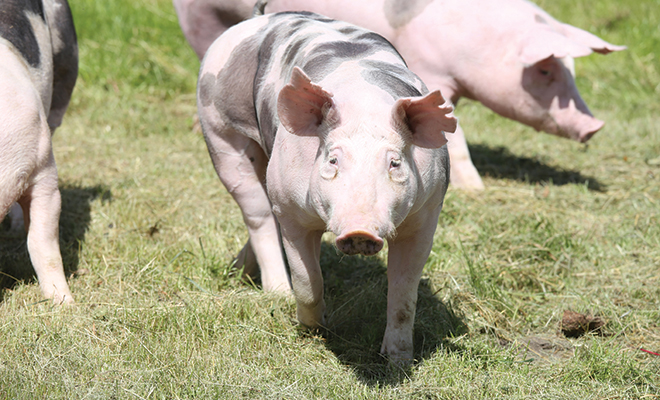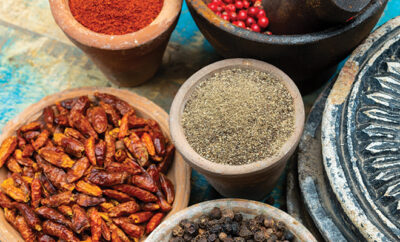
A Pig’s Heritage
Heritage pork is a culinary delight. The term “heritage” means “practices or characteristics that are passed down through the years, from one generation to the next,” according to Oxford Languages. So, how does that relate to heritage pork mentioned on restaurant menus?
In the United States, according to the Livestock Conservancy, only the Ossabaw Island and the Berkshire breeds are considered heritage swine breeds. In addition, crossbreeds bred from these two purebred lines may also be considered heritage swine.
The Ossabaw Island pigs are descendants of the Spanish Iberico pigs imported by Hernando De Soto, who brought 13 pigs to Tampa Bay, Florida, in 1539. The conditions in the new world were so favorable to the pigs that the herd reached 700 by 1542.
The purebred Berkshire, often considered the world’s best pig, was imported into the U. S. in 1823 from England. The pigs were discovered by Oliver Cromwell’s soldiers at Reading, in the shire of Berk, over 300 years ago. Their fame as pork of high quality and flavor caused their spread around the world.
Heritage pork is typically raised on small, independent farms. The animals are free to forage and often provided with comfortable barns for brutal winters and cool shade in hot months. Some specialty farmers feed their pigs with proprietary food to supplement their natural diet and give the meat an enhanced flavor.
The pigs are bred for sturdiness, lean and flavorful meat and market viability. This means just the opposite of mass-produced pork that may contain antibiotics, steroids, hormones and be fed GMO grains and fodder. For many small farmers, high costs and a labor-intensive work make raising heritage swine a work of love more than a high-income venture. In most cases, the pork is costlier than mass-produced pigs.
Is the extra cost worth it? Many say yes, because the meat has more fat, which makes the meat more tender, moist and flavorful. The flavor of heritage pork is also enhanced because of the free range the pigs frequently enjoy. By foraging, the pigs are able to add variety to their diet, naturally enhancing the flavor of their flesh.
Duroc
The Duroc is another pig preferred by connoisseurs. The origin of Duroc swine is somewhat muddy, but modern Durocs were developed from the Jersey Red of New Jersey and the Red Duroc of New York. They are prized for their heavy marbling and darker meat that’s more tender, tastier and juicier than other swine breeds.
Duroc pork products are often difficult to find. The pigs require special care, are few and far between, and have rigorous standards for their production. These conditions make them exclusive and alluring to those who seek a rare gourmet treat.
A major producer of pork products in the United States, Smithfield Foods, Smithfield, Virginia, uses Duroc pigs in their breeding program. The pigs are a cross between a male Duroc and a 50-50 cross between Landrace and Large White female hogs.
At Smithfield Foods, hogs may be fed grains that are GMO modified. However, Smithfield is quick to point out that many regulatory agencies, including the U. S. Food and Drug Administration and the Environmental Protection Agency have not found adverse effects from either humans or animals consuming these grains.
Commercially Produced Pork
Americans love their pork. In 2021, the per capita consumption was 51.1 pounds, and America’s farmers are providing for an expanding market. The largest pork farming operations in the United States are in Iowa, which raised approximately 23.5 million head, followed by Minnesota, with 9 million, and North Carolina, with 8 million in 2022. The United States exported around 7 billion pounds of pork in 2022 while importing about 1.3 billion pounds. Although China is by far the leading producer of pork in the world, followed by the European Union and the United States, little pork is exported from China to the United States.
The hog industry has changed drastically from the farrow-to-finishing operations of 50 years ago. The United States imports different-aged pigs and the different farming operations concentrate on a specific age group and their needs in the modern hog industry. For example, in 2022, the United States imported about 6.5 million live hogs for finishing operations from Canada, or about 5 percent of the federally inspected hogs slaughtered that year.
With millions of head of swine moving among the United States, the European Union and Canada, it is difficult for consumers to keep up with the genetics of each pork selection they make. Gourmets are particular about where their food was sourced, and when paying for a premium meal or cut of meat, the consumer has every right to demand this information, especially if it is fine heritage pork.
Sources: feastandfield.net, bonappetit.com, cotton-cattle-co.myshopify.com, eatberkshirepork.com, dpi.nsw.gov.au, choplocal.com, smithfieldfoods.com, statista.com and ers.usda.gov.







